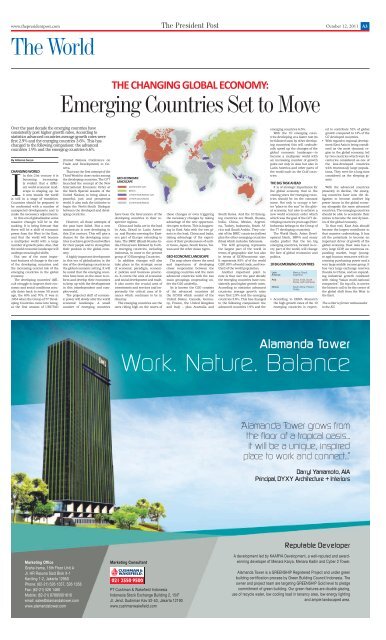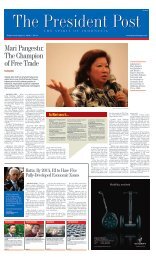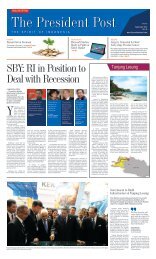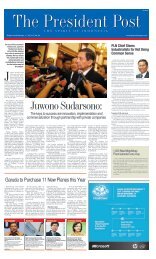28th Edition - The President Post
28th Edition - The President Post
28th Edition - The President Post
Create successful ePaper yourself
Turn your PDF publications into a flip-book with our unique Google optimized e-Paper software.
www.thepresidentpost.com <strong>The</strong> <strong>President</strong> <strong>Post</strong><br />
October 12, 2011 A3<br />
<strong>The</strong> World<br />
THE CHANGING GLOBAL ECONOMY:<br />
Emerging Countries Set to Move<br />
Over the past decade the emerging countries have<br />
consistently post higher growth rates. According to<br />
statistics advanced countries average growth rates were<br />
first 2.9% and the emerging countries 3.6%. This has<br />
changed to the following comparison: the advanced<br />
countries 1.9% and the emerging countries 6.6%.<br />
By Atmono Suryo<br />
CHANGING WORLD<br />
IIn this 21st century it is<br />
becoming increasingly<br />
evident that a different<br />
world economic landscape<br />
is shaping up. As<br />
it now stands the world<br />
is still in a stage of transition.<br />
Countries should be prepared to<br />
be confronted with a number of<br />
unexpected developments and to<br />
make the necessary adjustments.<br />
In this era of globalization some<br />
massive changes will be in the<br />
making. It is being forecast that<br />
there will be a shift of economic<br />
power from the West to the East,<br />
and that the world will become<br />
a multipolar world with a large<br />
number of growth poles. Also, that<br />
the world economic landscape will<br />
undergo meaningful shifts.<br />
But one of the most important<br />
features of change is the rise<br />
of the developing countries and<br />
the increasing central role of the<br />
emerging countries in the global<br />
economy.<br />
<strong>The</strong> developing countries’ difficult<br />
struggle to improve their economic<br />
and social conditions actually<br />
dates back to some 50 years<br />
ago, the 60’s and 70’s. It was in<br />
1964 when the Group of 77 Developing<br />
Countries came into being,<br />
at the first session of UNCTAD<br />
(United Nations Conference on<br />
Trade and Development) in Geneva.<br />
That was the first attempt of the<br />
Third World to close ranks among<br />
the developing countries. <strong>The</strong> G77<br />
launched the concept of the New<br />
International Economic Order at<br />
the Sixth Special session of the<br />
United Nations to bring about a<br />
peaceful, just and prosperous<br />
world. It also took the initiative to<br />
begin the North-South Dialogue<br />
between the developed and developing<br />
countries.<br />
However, all those attempts of<br />
the past have failed. But a new<br />
momentum is now developing in<br />
this 21st century. This will give a<br />
chance for the developing countries<br />
to achieve growth and welfare<br />
for their people and to strengthen<br />
their position in the global economy.<br />
A highly important development<br />
in this era of globalization is the<br />
rise of the developing countries in<br />
the global economic setting. It will<br />
be noted that the emerging countries<br />
have been on the move to reform<br />
and develop their economies<br />
to keep up with the developments<br />
in this interdependent and complex<br />
world.<br />
<strong>The</strong> projected shift of economic<br />
power will slowly alter the world<br />
economic landscape. A small<br />
number of emerging countries<br />
GEO-ECONOMIC<br />
LANDSCAPE<br />
ADVANCED G20<br />
BRICS<br />
OTHER EMERGING G20<br />
OTHER ADVANCED<br />
OTHER EMERGING<br />
have been the forerunners of the<br />
developing countries in their respective<br />
regions.<br />
China and India are in the lead<br />
in Asia, Brazil in Latin America<br />
and Russia covering the Eastern<br />
part of Europe extending to<br />
Asia. <strong>The</strong> BRIC (Brazil-Russia-India-China)<br />
were followed by 6 other<br />
emerging countries, including<br />
Indonesia, to come to the present<br />
group of 10 Emerging Countries.<br />
In addition changes will also<br />
take place in the strategic areas<br />
of economic paradigm, economic<br />
policies and business practices.<br />
It covers the area of economic<br />
and social development and trade.<br />
It also covers the crucial area of<br />
investments and services and importantly<br />
the critical area of finance<br />
which continues to be in<br />
disarray.<br />
<strong>The</strong> emerging countries are the<br />
ones riding high on the waves of<br />
these changes or even triggering<br />
the necessary changes by taking<br />
advantage of the new opportunities<br />
open to them. This is happening<br />
in East Asia with the two giants<br />
in the lead, China and India,<br />
taking advantage of the experience<br />
of their predecessors of earlier<br />
times, Japan, South Korea, Taiwan<br />
and the other Asian tigers.<br />
GEO-ECONOMIC LANDSCAPE<br />
<strong>The</strong> map above shows the need<br />
and importance of developing<br />
closer cooperation between the<br />
emerging countries and the more<br />
advanced countries with the two<br />
main groupings cooperating under<br />
the G20 umbrella.<br />
As is known the G20 consists<br />
of the advanced countries (of<br />
the G7/G8 which consist of the<br />
United States, Canada, Germany,<br />
France, the United Kingdom<br />
and Italy – plus Australia and<br />
South Korea. And the 10 Emerging<br />
countries are Brazil, Russia,<br />
India, China, Mexico, Argentina,<br />
Turkey, Indonesia, South Africa<br />
and Saudi Arabia. <strong>The</strong>y consist<br />
of the BRIC countries (yellow)<br />
plus the other emerging countries<br />
(blue) which includes Indonesia.<br />
<strong>The</strong> G20 grouping represents<br />
the largest part of the world in<br />
terms of geographic size but also<br />
in terms of GDP/economic size.<br />
It represents 85% of of the world<br />
GDP, 80% of world trade, and twothird<br />
of the world population.<br />
Another important point to<br />
note is that over the past decade<br />
the emerging countries have consistently<br />
post higher growth rates.<br />
According to statistics advanced<br />
countries average growth rates<br />
were first 2.9% and the emerging<br />
countries 3.6%. This has changed<br />
to the following comparison: the<br />
advanced countries 1.9% and the<br />
emerging countries 6.6%.<br />
With the 10 emerging countries<br />
developing at a faster rate (to<br />
be followed soon by other developing<br />
countries) this will undoubtedly<br />
speed up the changes of the<br />
global economic landscape—to<br />
become a multipolar world with<br />
an increasing number of growth<br />
poles not only in Asia but also in<br />
Latin America and other parts of<br />
the world such as the Gulf countries.<br />
THE BIG TASK AHEAD<br />
It is of strategic importance for<br />
the global economy that in the<br />
coming years the emerging countries<br />
should be on the constant<br />
move. Not only to occupy a better<br />
“place in the sun” in the global<br />
economy, but also to achieve a<br />
new world economic order which<br />
which was the goal of the G77 developing<br />
countries years ago (Note:<br />
Indonesia belongs to the Group of<br />
the 77 developing countries).<br />
<strong>The</strong> World Bank, Asian Development<br />
Bank, BBVA and many<br />
media predict that the ten big<br />
emerging countries, located in every<br />
part of the world, will change<br />
the face of global economics and<br />
politics.<br />
10 BIG EMERGING COUNTRIES<br />
Latin<br />
America<br />
: Mexico, Brazil,<br />
Argentina<br />
Asia : China, India, South<br />
Korea, and Indonesia<br />
Others : South Africa, Poland,<br />
Turkey<br />
• According to BBVA Research<br />
the high growth rates of the 10<br />
emerging countries is expect-<br />
ed to contribute 51% of global<br />
growth compared to 14% of the<br />
G7 developed countries.<br />
• With regard to regional development<br />
East Asia is being considered<br />
as the most dynamic region<br />
in the global economy, led<br />
by two countries which were for<br />
centuries considered as one of<br />
the less-developed countries<br />
with enormously large populations.<br />
<strong>The</strong>y were for a long time<br />
considered as the sleeping giants.<br />
With the advanced countries<br />
presently in decline, the emerging<br />
countries have now the obligation<br />
to become another big<br />
power house in the global economy<br />
alongside the more advanced<br />
countries. <strong>The</strong> emerging countries<br />
should be able to accelerate their<br />
moves to become the new dynamics<br />
of the global economy.<br />
To that end, East Asia should<br />
become the largest contributor in<br />
that massive undertaking. It has<br />
all the potentials to become an<br />
important driver of growth of the<br />
global economy. East Asia has a<br />
very large GDP, an enormous expanding<br />
market, huge (younger<br />
age) human resources with increasing<br />
purchasing power and a<br />
very large middle income group. It<br />
has very large exchange reserves<br />
thanks to China, and an expanding<br />
industrial growth combined<br />
with rising “Asian multi-national<br />
companies”. On top of it, it carries<br />
the historic call to be the center of<br />
the global shift from the West to<br />
the East.<br />
<strong>The</strong> writer is former ambassador<br />
to the EU.<br />
Alamanda Tower<br />
Work. Nature. Balance<br />
“Alamanda Tower grows from<br />
the floor of a tropical oasis...<br />
it will be a unique, inspired<br />
place to work and connect...”<br />
Darryl Yamamoto, AIA<br />
Principal, DYXY Architecture + Interiors<br />
Reputable Developer<br />
Marketing Office<br />
Graha Irama, 15th Floor Unit A<br />
Jl. HR Rasuna Said Blok X-1<br />
Kavlling 1-2, Jakarta 12950<br />
Phone: (62-21) 526 1357, 526 1358<br />
Fax: (62-21) 526 1460<br />
Mobile: (62-21) 87885001616<br />
email: sales@alamandatower.com<br />
www.alamandatower.com<br />
Marketing Consultant<br />
PT Cushman & Wakefield Indonesia<br />
Indonesia Stock Exchange Building 2, 15/F<br />
Jl. Jend. Sudirman Kav 52-53, Jakarta 12190<br />
www.cushmanwakefield.com<br />
A development led by KAARYA Development, a well-reputed and awardwinning<br />
developer of Menara Karya, Menara Kadin and Cyber 2 Tower.<br />
Alamanda Tower is a GREENSHIP Registered Project and under green<br />
building certification process by Green Building Council Indonesia. <strong>The</strong><br />
owner and project team are targeting GREENSHIP Gold level to pledge<br />
commitment of green building. Our green features are double glazing,<br />
use of recycle water, low cooling load in tenancy area, low energy lighting<br />
and ample landscaped area.








